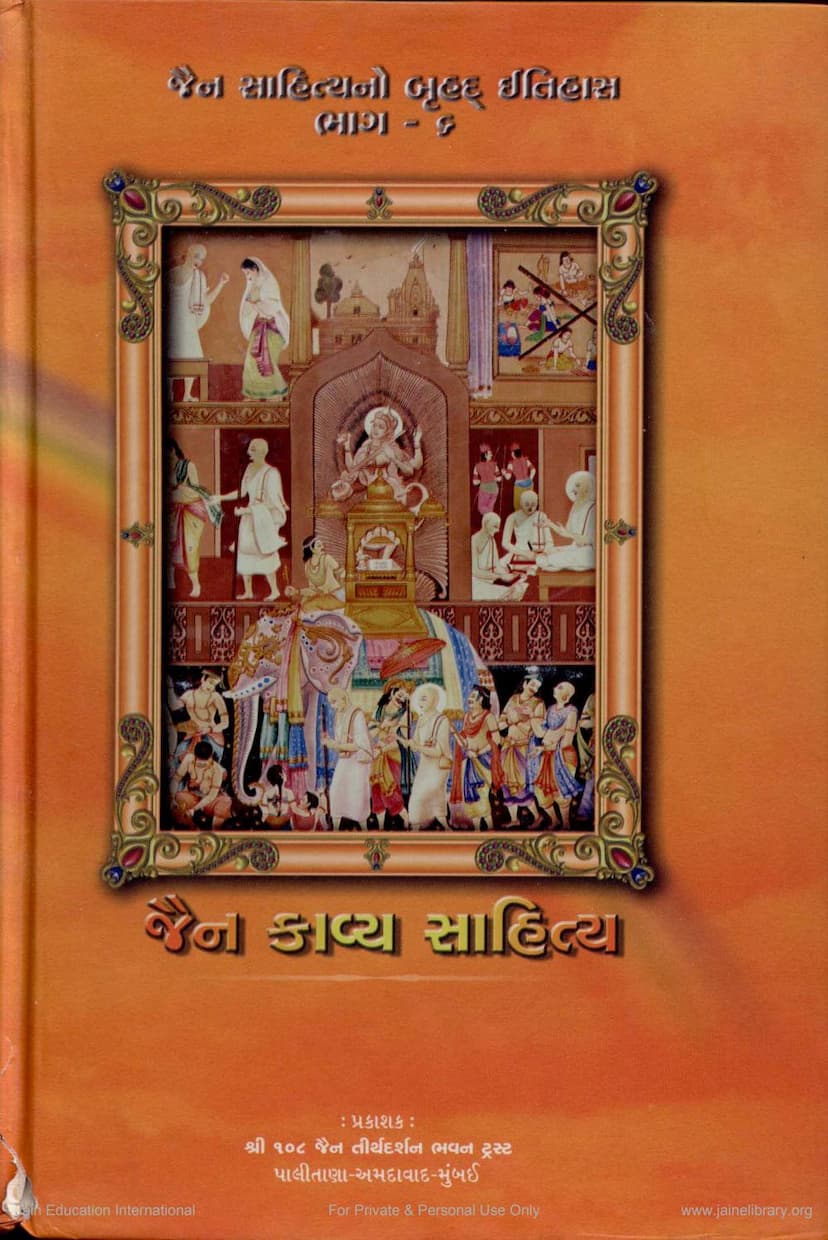Jain Kavya Sahitya Jain History Series 6
Added to library: September 2, 2025

Summary
This is a comprehensive summary of the Jain text "Jain Kavya Sahitya" (Book Title), authored by Gulabchandra Chaudhary, published by Shri 108 Jain Tirthdarshan Bhavan Trust, as indicated by the provided catalog link and page information. The text is part of the "Jain History Series 6" and focuses on Jain Poetic Literature in Sanskrit and Prakrit.
Here's a breakdown of the key aspects covered in the provided text:
Overall Scope:
- Focus: The book provides a detailed history of Jain poetic literature, primarily focusing on works composed in Sanskrit and Prakrit.
- Structure: The literature is broadly categorized into three main sections:
- Mythological Epic Poetry: Including Jain Mahakavyas and all types of Kathas (narrative poems, often referred to as "Katha" in Prakrit).
- Historical Literature: Encompassing historical poems, Prabandha literature, inscriptions (Prashastis), lineage records (Pattavalis, Guravalis), idol inscriptions (Pratimalekh), other epigraphs, and pilgrimage accounts (Tirthamalas, Vijnaptipatras).
- Lalit Vakya (Fine Arts Literature): Covering classical Mahakavyas, prose poetry (Gadyakavya), Champukavya, musical poetry (Gitikavya), dramatic poetry (Drushyakavya), and poems of multiple meanings (Sandhani).
- Language: While acknowledging Jain literature in various languages (Tamil, Kannada, Marathi, Gujarati, Rajasthani, Hindi), this specific volume concentrates on literature available in Sanskrit and Prakrit. Apabhramsha and other language literature will be covered in other volumes.
- Historical Context: The text emphasizes the importance of understanding the political, religious, social, and literary conditions of the era in which the literature was created.
Key Themes and Content:
- Jain Contribution to Indian Literature: It highlights the significant and diverse contributions of Jain scholars (Jainacharyas) to Indian literature across various fields, including grammar, poetry, history, lexicography, astronomy, medicine, and more.
- Historical Periods Covered: The literature discussed spans approximately 2500 years, from the time of Lord Mahavir to the end of the 20th century. The text mentions the classification of Jain literature into Agamic, Anu-agamic, and Agam-etar, with prior volumes in the series likely covering the first two.
- Religion and Society: The text details the influence of political patronage, religious fervor, and the evolving social structure on Jain literature. It touches upon the rise of the Bhakti movement, Tantric influences, and the development of monastic orders (Gachhas, Sanghas).
- Key Figures: It acknowledges the profound impact of prominent Jain Acharyas like Hemchandracharya (Kalicālavsarvajña), a preeminent figure compared to any other in the last thousand years in the realm of asceticism and literature. The text also mentions the influence of Jain Acharyas and intellectuals from various traditions (Shvetambar and Digambar).
- Literary Styles and Forms: The book meticulously categorizes and describes various forms of Jain poetic literature, including:
- Mahakavyas: Discussing their characteristics, themes (lives of Tirthankaras, great figures like Ram, Krishna, Pandavas), and classification into Pauranik (Mythological) and Aitihasik (Historical) Mahakavyas.
- Kathas/Upakhyanas: Highlighting the vast narrative literature, including moral stories, folk tales, and illustrative stories used in religious discourse (Dharmakathanuyoga).
- Prabandha Literature: Detailing works that blend history with poetry and narrative, often focusing on influential figures and events.
- Prashastis: Inscriptions praising patrons, scholars, authors, and their works.
- Pattavalis & Guravalis: Lineage records of spiritual leaders.
- Lalit Vakya: Including classical Mahakavyas, Gadyakavya (prose poetry), Champukavya, and plays (Nataka).
- Specific Literary Works Discussed: The text mentions and provides summaries or overviews of numerous specific Jain works, including:
- Ramayana Cycle: Vimalasuri's Paumchariyum (Pramacarita), Ravishēṇa's Padmacarita (Padma Purana), Hemachandra's Trishashtishalaka-purushacharita (Trishashti Shalaka Purusha Charita), and others.
- Mahabharata Cycle: Jinaseṇa's Harivanshapurāṇa and Pandavacharitra by various authors are mentioned.
- Purana Literature: Jinaseṇa and Guṇabhadra's Mahapurana (Adipurana and Uttarapurana) are highlighted for their encyclopedic nature.
- Prabandhas: Works like Prabandhachintamani (Mērutuṅga), Prabandhakōśa (Rajasekhara), and Prabandhavali (Jinabhadra) are discussed for their historical and anecdotal content.
- Specific Works: The text lists and briefly describes numerous works related to Tirthankaras (e.g., Ajitanatha Purana, Shreyanatha Charita, Neminatha Mahakavya, Parshvanatha Charita), prominent historical figures (e.g., Vimalamontri Charita, Jagdu Charita), and philosophical or didactic literature.
- Inspirations for Creation: The text identifies several driving forces behind the creation of Jain poetic literature, including:
- Religious devotion and the desire to spread Jain teachings.
- Patronage from royalty and wealthy individuals.
- Competition among monastic lineages (Gachhas) to achieve prestige.
- The need to present ideals of exemplary lives.
- Imitation of popular styles and works from other Indian traditions.
- Inherent generosity and tolerance in religious outlook.
- Literary Analysis: The text delves into the characteristics of Jain Mahakavyas, comparing them with Western and Indian epic traditions, analyzing their structure, themes, characters, and stylistic elements. It discusses the integration of mythology, history, and philosophical concepts.
Publisher and Support:
- The publisher is Shri 108 Jain Tirthdarshan Bhavan Trust (Shri Samavsaran Mahamandir), Palitana-Ahmedabad-Mumbai.
- The publication received support from Shri Santacruz Jain Tapagachch Jain Sangh, Santacruz, Mumbai.
- The Gujarati edition's editors are Dr. Nagin Shah and Dr. Ramnik Shah.
Key Takeaways:
- This book is a scholarly endeavor to catalog and analyze the vast and diverse body of Jain poetic literature in Sanskrit and Prakrit.
- It demonstrates the Jain tradition's deep engagement with literary arts, using poetry and narrative to convey religious, ethical, and historical information.
- The text reveals the Jain community's active participation in cultural and historical preservation through their literary output and patronage.
- The detailed listing of works and authors suggests a rich and well-documented literary tradition within Jainism.
In essence, "Jain Kavya Sahitya" is presented as a foundational work for understanding the immense poetic and literary heritage of Jainism in Sanskrit and Prakrit, tracing its evolution, key figures, and contributions to the broader Indian literary landscape.